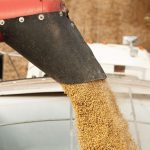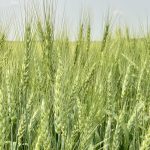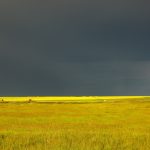Severe storms brought strong winds, heavy rains, and, in some places, golf ball-sized hail over parts of Saskatchewan. Nevertheless, the province’s harvest continued to progress during the week ended Aug. 26, according to the agriculture department’s weekly crop report.
Chickpeas

Saskatchewan Crop Report: Harvest marches on despite rains, hail

Saskatchewan Crop Report: Harvest continues amidst scattered storms
Saskatchewan reported 15 per cent of its harvest was complete, compared to 21 per cent at this time last year, but higher than the five-year average of 13 per cent and the 10-year average of 11 per cent. In the southwest region, 29 per cent of its harvest was complete while the northwest region was only at one per cent complete.

AAFC revise grain figures in August estimates
Days before Statistics Canada presents its monthly principal field crop estimates, Agriculture and Agri-Food Canada (AAFC) released its estimates on Aug. 20, showing some changes to grains from the month before.

Combines making their rounds in Alberta
s the harvesting of fall crops in Alberta exceeded the halfway point, the combining of the province’s spring cereals was just beginning, according to the latest Alberta crop report.

Saskatchewan crops advance rapidly: report
Hot temperatures and a lack of moisture saw crops in Saskatchewan continue to advance rapidly during the week ended Aug. 5, according to the latest provincial crop report, with the […] Read more

Pulse Weekly: Pea prices decline as harvest gets closer
Delivered prices for green peas across the Prairies ranged from C$12.50 to C$14.21 per bushel as of July 26, according to Prairie Ag Hotwire. The latter price was down C$4.27 from last month but only four cents lower than last year. For yellow peas, delivered prices ranged from C$9.75 to C$11.40/bu., down C$1.60 from last month and down C$1.40 from last year.

Pulse Weekly: Heat hasn’t affected Saskatchewan crops … yet
After heavy rainfall earlier this summer caused flooding in low-lying areas and washed out some pulse acres, Dale Risula said growers couldn’t wait for the heat to help crops develop. Now, the warmer and drier conditions are doing more harm than good.

Alberta crops holding their own for now
Alberta reported its crops were still in good shape despite temperatures pushing above 30 degrees Celsius and a lack of rain as of July 16. The report put the overall rating for the province’s crops at 74 per cent good to excellent, seven points above the five-year average.

Cereals withstood storms better: CCHA
Approximately 1,000 crop damage claims made from storms between June 23 and July 1
“Numerous early season storms have resulted in a number of claims for the industry,” CCHA Chairman Scott McQueen of Palliser Insurance said in a statement. “Cereals have generally fared better as many were hit in the grassy stages of development and minimal damage to the plant was caused with environmental conditions being favourable so that crops that were hit by hail are able to recover.”

Saskatchewan Crop Report: Warm conditions advancing crop development
Warm and mostly dry conditions across Saskatchewan helped crops advance in their development during the week ended July 8, according to the latest provincial report.
